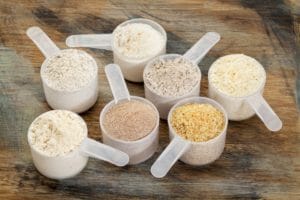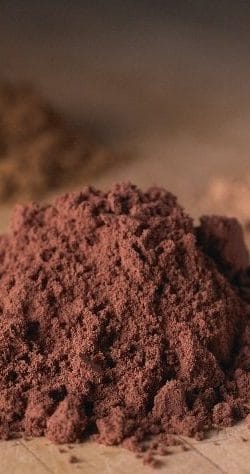
Just one plain flour could produce thousands of recipes – or so was the case until my celiac diagnosis. Suddenly that lone component had to be replaced by a combination of three, four or more.
But as I soon discovered, experimenting with gluten-free flours adds a new dimension of flavors and textures that aren’t possible when working only with wheat flour. Plus by understanding the taste, consistency and composition of other gluten-free baking ingredients and how to use them, the sweet smell of success becomes easy to achieve.
Gluten-free carries the stigma of dense muffins, dry cakes and crumbly cookies, but unbalanced proportions in any baked good recipe, even wheat-based, can produce disappointing results. The key to praiseworthy pastries is mixing the proper ratio of ingredients. Gluten-free baking requires a balance of what I call neutral flours, higher protein flours, starches and, if needed, binders.
Neutral flours provide the foundation with modest protein for structure and no overpowering flavor. Examples include sorghum flour, gluten-free oat flour and brown or white rice flour (ideally superfine to avoid a gritty texture).
Higher protein flours are used in smaller amounts (15-25 percent of the flour blend) to help fortify the base and add an element of flavor. These include almond (Which can also work as neutral flour), amaranth, buckwheat, chickpea, garfava, millet, quinoa and teff flours.
Starches have a gelatinous quality that assists binding, but their lack of fiber and protein lightens the overall texture. I limit starches to 25 percent of flour blends for everyday baking, and 40 percent for desserts. The most widely available options are corn- starch, potato starch, tapioca starch/flour, arrowroot starch/flour and sweet rice flour.
Binders step in when additional cohesiveness is required. Although higher protein flours and starches help dough to bond, too much of either will result in a dense or gummy texture. Xanthan gum and guar gum (for corn-free) are the most readily available binders.
To 1 cup of gluten-free flour blend, add 1 teaspoon of gum for yeast-based recipes; 3/4 teaspoon in quick breads and cookies; and 1/2 teaspoon for lighter baked goods.
Flour Blends
The flour combining possibilities are endless, but I do have some staple mixes that perform well as a 1:1 substitution for all-purpose wheat flour. The first creates perfectly tender quick breads, muffins, cookies and bars.
Basic Baking Blend
- 1 1/4 cups sorghum flour
- 1/2 cup tapioca starch
- 1/4 cup quinoa flour
- 3/4 tsp xanthan or guar gum
For a heartier version, reduce the starch to 1/4 cup and increase the quinoa flour to 1/2 cup.
Cake Blend
When fluffy cakes and dainty cupcakes are on order, the next combination is a miracle worker. Millet flour perfects the delicate crumb, arrowroot starch provides a light structure, and tapioca starch encourages a tender bite.
- 11/4 cups sorghum flour
- 1 cup millet flour
- 1/2 cup arrowroot starch
- 1/4 cup tapioca starch
- 1 1/2 tsp xanthan or guar gum
Flour Blend for Yeast-Based Bread
The next combination creates bread with a soft and light texture that is sturdy enough for sandwiches. Works well as a 1:1 replacement for flour or all-purpose gluten-free flour blends in yeast-based recipes.
- 4 cups sorghum flour
- 3 cups buckwheat flour
- 1‚Öì cup arrowroot starch
- 1 cup tapioca starch
- 3 tbsp xanthan gum
What’s Trending?
Gluten-free bakers have reason to get excited thanks to the rapid expansion of our pantry options. Food producers have become acutely aware of the growing gluten-free market, and are responding with numerous new ingredients. Couple this with curious bakers who have a penchant for making old ingredients new again, and gluten-free baking is being propelled from a struggle to an adventure. Here are a few of the latest and greatest to consider for your next experiments.
 Psyllium seed husks
Psyllium seed husks Psyllium Husk or Powder:
This soluble fiber is quickly gaining recognition as a gum-replacement in gluten-free baking. It readily absorbs moisture (increasing shelf life) and becomes gelatinous when mixed with water. Psyllium works best in recipes that require higher levels of gluten and can withstand its unrefined flavor, like yeast bread and pizza crust. Start with 1 to 2 tablespoons per 1 cup of flour blend.
Expandex:
Also known as modified tapioca starch, Expandex is a branded product that has long been used in commercial mixes, and is now available to consumers. It adds moisture, increases shelf life, and reportedly negates the need to toast or heat leftovers when it’s added to sorghum or bean Hour-based recipes or swapped for a portion of rice flour.
Coconut Flour:
Rising to the peak of popularity, this grain-free neutral flour is tops in fiber, but such status isn’t without consequence. Coconut flour is very dry, and absorbs liquid like a sponge.
When experimenting, start by replacing 1 cup flour with 1/4 cup coconut flour, and let it sit for 20 minutes. If the mixture is too dry, add up to 1/4 cup liquid, or more as needed. If tolerated, eggs can assist in the moisture and binding of coconut flour; add 2 to 3 eggs per 1/2 cup of coconut flour.
 Baking gets unique flavor and color with grape skin flour.
Baking gets unique flavor and color with grape skin flour. Grape Skin Flour:
Many vintners are now developing higher protein flour from ground grape seeds and skins. lt imparts a bold, unique flavor (and often color) to baked goods, is rich in antioxidants, and is best used in small amounts – a little goes a long way.
Kaniwa Flour:
Hailing from the Andes, Kaniwa is similar to quinoa in origin, taste and protein levels. It adds a slightly earthy flavor, and can be used in place of other protein flours for most gluten-free recipes.
Sweet Potato Flour:
Made from white or yellow sweet potatoes, this fibrous neutral flour adds a slight sweetness and gentle moisture to baked goods. It weighs more than most gluten-free flours, and thus should be used in a ratio of 7/8 cup per 1 cup flour called for in the recipe.
Secrets to Success
Years of experimentation have rewarded me with a sizeable repertoire of essential tips. Following are a few that will help propel your gluten-free baking to tasty new heights.
Weight Matters:
Ditch the measuring cups and invest in an inexpensive kitchen scale to dramatically improve your results. Beyond balancing fiber and protein, weight is crucial for mimicking wheat flour, which clocks in at 140 grams (5 ounces) per 1 cup. Gluten-free flours and starches tend to vary significantly by weight, but tallying them to achieve 140 grams per cup of replaced wheat flour will help to produce a satisfactory texture and density in your final baked good.
Lighten Up:
Cider vinegar provides moisture, shelf life, lift (especially for eggless baking), tenderness and flakiness to most baked goods. If it isn’t already in the recipe, use it as a substitute for 1 to 2 tablespoons of the recipe liquid.
Avoid Sticky Situations:
If your budget allows, invest in a heavy-duty stand mixer, It will handle the tacky kneading and sizable girth of gluten-free yeast- based breads; hand mixers quickly burn out. Also, seek out good quality pans (I prefer commercial-grade aluminized steel baking pans) and line with lightly greased parchment paper, a silicone baking mat or cupcake liners for easy release.
Repurpose Mistakes:
Flops are inevitable, but even disasters can triumph when made into bread pudding, used as a crumble topping, layered in a trifle or mixed into ice cream. Embrace mishaps, they might still result in a favorite new gluten-free recipe.
Laurie Sadowski is a gluten-free author and baking expert. Her titles include The Allergy-Free Cook Bakes Bread and The Allergy-Free Cook Bakes Cakes and Cookies. Visit her at www.lauriesadowski.com
Related:
Cybele’s Basic Gluten-Free Flour Blend
About Using Gluten-Free Flour Blends





